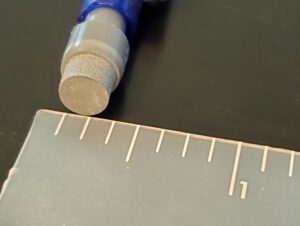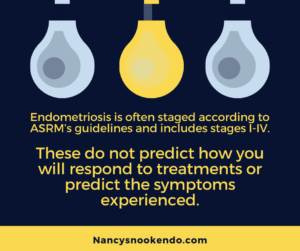Staging
So you’ve been told your endometriosis is a certain stage, but what does that mean?
The most widely used staging system for endometriosis, the American Society of Reproductive Medicine’s (ASRM), is based on how it affects fertility, not how it affects symptoms. Others systems of classification/staging focus on fertility or how the anatomy is affected (such as the Enzian classification for deep endometriosis, the endometriosis fertility index (EFI), and the American Association of Gynecological Laparoscopists (AAGL) classification) (Johnson et al., 2017). These do not take into consideration the biochemical effects of endometriosis (Imanaka, 2020). None of the systems “predicts pelvic pain, response to medications, disease recurrence, risks for associated disorders, quality of life measures, and other endpoints important to women and health care providers for guiding appropriate therapeutic options and prognosis” (Johnson et al., 2017, para. 3).
The ASRM’s classification system “classifies the disease as minimal (Stage I), mild (Stage II), moderate (Stage III) or severe (Stage IV)” based on a point system for how deep lesions go, the number of lesions, if cysts are on the ovaries, and adhesions (Khine, Taniguchi, & Harada, 2016, para. 12). A newer staging system called the endometriosis fertility index (EFI) “was developed…to predict fecundity after endometriosis surgery” and “could be useful as a clinical tool for counseling patients with endometriosis after surgery about their fertility prognosis and eventual need for fertility treatment” (Khine, Taniguchi, & Harada, 2016, para. 13).
None of these predict how you will respond to treatments or predict the symptoms experienced. Some will have Stage IV but have minimal symptoms. Others will have “minimal” disease but severe symptoms.
Endometriosis is divided into three main phenotypes: ovarian endometrioma (OMA), superficial peritoneal endometriosis (SPE), and deep infiltrating endometriosis (DIE). Here we’ll briefly discuss SPE and DIE.
Categories of Endometriosis
Superficial peritoneal endometriosis
Superficial peritoneal endometriosis (SPE) is defined as lesions less than 5 mm deep (Daly, 2018). Although superficial, SPE can cause moderate to severe symptoms as well as infertility (Reis et al., 2020). The appearance or staging of endometriosis does not reflect the biochemical mechanisms of endometriosis (Imanaka, 2020). You can read more about those mechanisms here.
Deep Infiltrating Endometriosis
“Deep infiltrating endometriosis (DIE) represents 15 to 30% of endometriosis cases and is defined as endometriosis infiltrating the peritoneum by more than 5 mm. DIE is characterized by nodules infiltrating the rectosigmoid, uterosacral ligaments (USL), vaginal fornix, rectovaginal septum (RVS) and/or bladder.”
(Daly, 2018, para. 1)
(For reference, a millimeter is 0.039 of an inch. 5 mm would be about the length of a pencil’s eraser.)

DIE is associated with severe pain, and it has been noted to be important to resect (i.e. remove) these lesions in order to treat the pain (Yi, Leng, Lang, Ll, & Zhang, 2012). Your surgeon should be skilled and work with a multi-disciplinary team if DIE is present, because it can affect areas such as the bowel and ureters (Yi et al., 2012). Your surgeon should also know that ovarian endometriosis (or endometriomas) is associated with pelvic endometriosis and DIE, and should be prepared to address endometriosis in other areas as well (Exacoutos et al., 2018).
“Of the 177 DIE patients, 336 lesions were proved both histologically and laparoscopically as DIE lesions. The anatomical distributions of all DIE endometriotic lesions (number of patients, percentage) were as follows: bladder (5, 1.58%), uterosacral ligament (95, 67.08%), cul-de-sac (37, 12.02%), recto-vaginal septum (40, 12.66%), rectum and rectosigmoid junction (9, 2.85%) and ureter (12 lesions, 3.80%). Twenty-seven (67.5%) recto-vaginal septum lesions infiltrated deeply into the vaginal fornix. The 139 deeply infiltrating lesions on uterosacral ligaments (USL) included 29 on the left side, 37 on the right side and 73 were bilateral. The bladder was only anterior pelvic lesions in the DIE patients. While posterior pelvic lesions were more widespread and more severe in this group of DIE patients.”
(Yi et al., 2012, para. 15)
Ovarian Endometrioma
Endometriomas are a type of endometriosis found as a cyst on the ovary. It “contains thick, brown, tar-like fluid, which may be referred to as a ‘chocolate cyst'” (UpToDate, 2021). “Ovarian endometriomas are found in up to 44% of women with endometriosis, and are significantly associated with the presence of pelvic deep infiltrating endometriosis, ovarian adhesions, and pouch of Douglas obliteration” (Cranney, Condous, & Reid, 2017).
References
Cranney, R., Condous, G., & Reid, S. (2017). An update on the diagnosis, surgical management, and fertility outcomes for women with endometrioma. Acta obstetricia et gynecologica Scandinavica, 96(6), 633-643. Retrieved from https://obgyn.onlinelibrary.wiley.com/doi/full/10.1111/aogs.13114
Daly, S. (2018). Imaging in Endometrioma/Endometriosis. Medscape. Retrieved from https://emedicine.medscape.com/article/403435-overview#a1
Demco, L. (2000). Review of pain associated with minimal endometriosis. JSLS: Journal of the Society of Laparoendoscopic Surgeons, 4(1), 5. Retrieved from http://www.ncbi.nlm.nih.gov/pmc/articles/PMC3015350/
Exacoustos, C., De Felice, G., Pizzo, A., Morosetti, G., Lazzeri, L., Centini, G., … & Zupi, E. (2018). Isolated ovarian endometrioma: a history between myth and reality. Journal of minimally invasive gynecology, 25(5), 884-891. Retrieved from https://www.jmig.org/article/S1553-4650(18)30042-6/fulltext?fbclid=IwAR1yOvqvObWgpldiQ-VAwvju8uGNqQz0-edmbhZluYmDvTfanlCQJcniTEQ
Imanaka, S., Maruyama, S., Kimura, M., Nagayasu, M., & Kobayashi, H. (2020). Towards an understanding of the molecular mechanisms of endometriosis-associated symptoms. World Academy of Sciences Journal, 2(4), 1-1. Retrieved from https://www.spandidos-publications.com/10.3892/wasj.2020.53
Johnson, N. P., Hummelshoj, L., Adamson, G. D., Keckstein, J., Taylor, H. S., Abrao, M. S., … & Rombauts, L. (2017). World Endometriosis Society consensus on the classification of endometriosis. Human reproduction, 32(2), 315-324. Retrieved from https://academic.oup.com/humrep/article/32/2/315/2631390
Khine, Y. M., Taniguchi, F., & Harada, T. (2016). Clinical management of endometriosis-associated infertility. Reproductive medicine and biology, 15(4), 217-225. Retrieved from https://www.ncbi.nlm.nih.gov/pmc/articles/PMC5715862/
UpToDate. (2021). Endometriosis: Management of ovarian endometriomas. Retrieved from https://www.uptodate.com/contents/endometriosis-management-of-ovarian-endometriomas
Reis, F. M., Santulli, P., Marcellin, L., Borghese, B., Lafay-Pillet, M. C., & Chapron, C. (2020). Superficial peritoneal endometriosis: clinical characteristics of 203 confirmed cases and 1292 endometriosis-free controls. Reproductive Sciences, 27(1), 309-315. Retrieved from https://link.springer.com/article/10.1007/s43032-019-00028-1
Yi, D. A. I., Leng, J. H., Lang, J. H., LI, X. Y., & Zhang, J. J. (2012). Anatomical distribution of pelvic deep infiltrating endometriosis and its relationship with pain symptoms. Chinese medical journal, 125(2), 209-213. Retrieved from https://journals.lww.com/cmj/Fulltext/2012/01020/Anatomical_distribution_of_pelvic_deep.10.aspx

